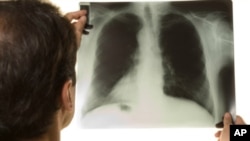Nearly 10 million new cases of tuberculosis are expected this year. The disease is more prevalent than ever, and the world's drug researchers don't seem to be making much headway.
Tuberculosis is a stubborn disease to treat. The current regimen for standard cases involves four different medicines taken over six months. More powerful medicines are needed for drug-resistant strains, and some varieties are hard to treat with any drugs.
Most recent tuberculosis drugs are variations on previous medicines. Anil Koul, a researcher with drug maker Johnson & Johnson, notes that the last TB drug with a completely new mechanism, rifampicin, was discovered almost a half-century ago. There are now just a handful of potential TB drugs in development, and some are variations of existing drugs, or scaffolds.
"With just nine drugs in the pipeline, with lots of resistance issues - some of these drugs being re-engineered scaffolds and with lots of post-approval failures in the drug industry, I think lots of work still needs to be done," he says.
Koul attributes the relatively small number of possible new tuberculosis drugs to complacency and a sense that progress was being made with existing drugs.
"The disease was in decline, people thought we eradicated it," Koul explained. "Then we stopped thinking about the disease and the innovation that was needed. This also had a knock-out effect on the funding, there was no funding available to really start any pharmaceutical projects, to really discuss innovative approaches for TB."
The United Nations has set eradication of tuberculosis by 2050 as one of its Millennium Development Goals. Koul says that would require speeding up drug development - moving from an underpowered economy sedan to a sports car is the analogy he used. But with most TB victims being among the world's poor and marginalized people, he said better drugs are only part of the answer.
"We need preventive measures. I think we also need proper access - how to bring these pharmaceuticals, which are currently in the pipeline, to these poor patients."
Those preventive measures, plus removing the social stigma of tuberculosis, says Koul.








